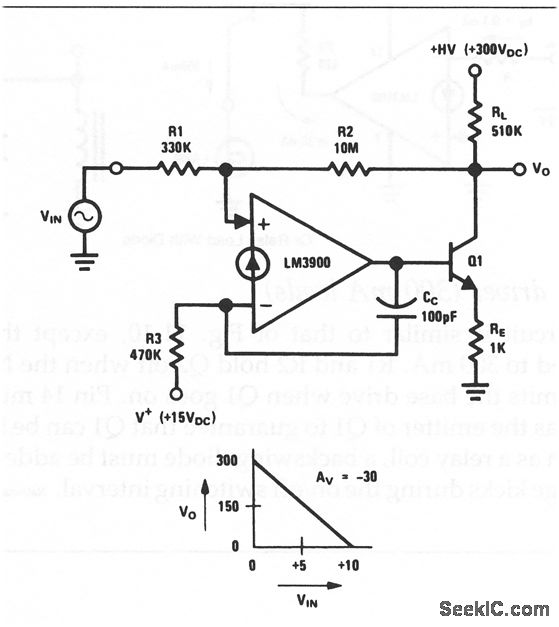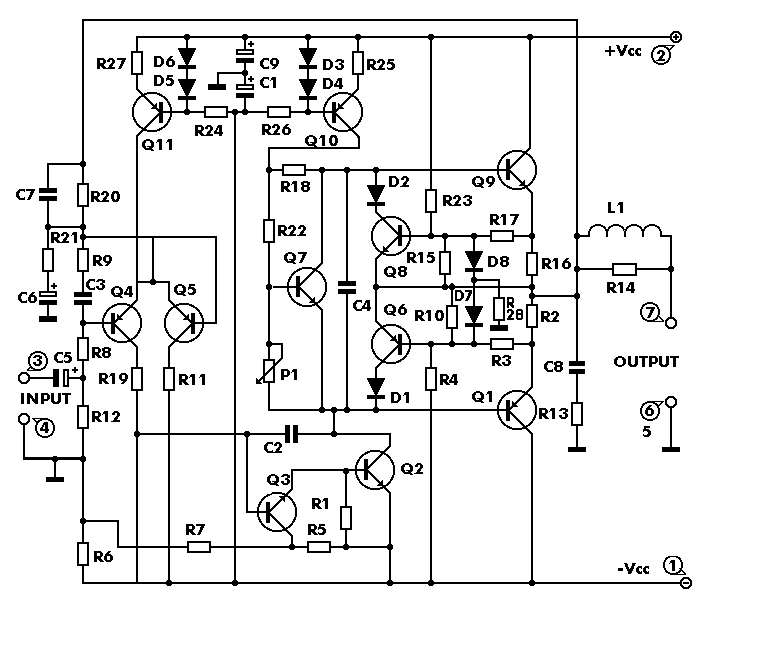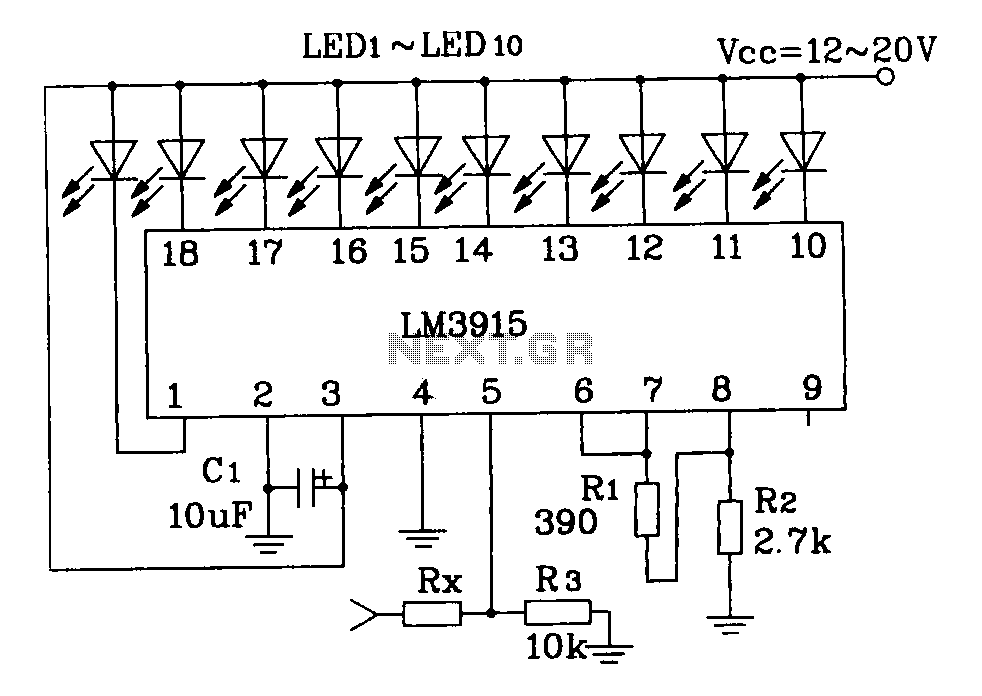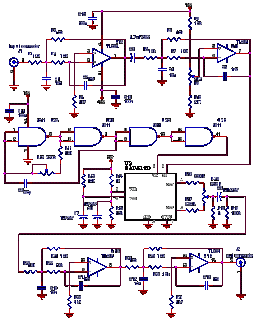
audio peak level indicator by op amp
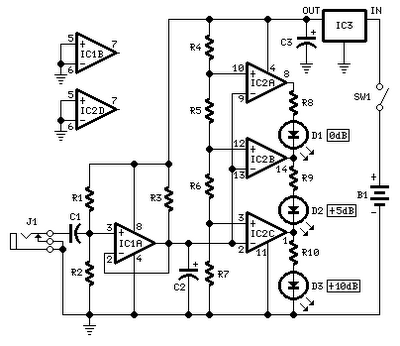
No setup is required: if correct values are used for resistors R3 to R7, LED D1 will illuminate at 0 dB input (0.775V RMS), LED D2 at +5 dB input (1.378V RMS), and LED D3 at +10 dB (2.451V RMS). The circuit was optimized for low current consumption as it was intended for battery operation. To achieve this, the best arrangement has proven to be the one using two different op-amp types for IC1 and IC2. In fact, the LM393 IC was not operating satisfactorily as a dot-mode LED driver, whereas the LM324 was unable to charge C2 in the linear way, as expected. Therefore, the final circuit involves some op-amp wastage, but the small added cost will be quickly compensated by battery savings.
The described circuit functions as a visual audio level indicator using three LEDs to represent different input signal levels. The resistors R3 to R7 are selected to ensure that LED D1 lights up at a nominal input level of 0 dB, corresponding to 0.775V RMS. As the input signal increases to +5 dB (1.378V RMS) and +10 dB (2.451V RMS), LEDs D2 and D3 illuminate, respectively. This functionality allows users to easily monitor audio levels, ensuring that signals remain within an acceptable range without distortion.
The circuit's design prioritizes low power consumption, making it suitable for battery-operated applications. This is particularly important in portable devices where battery life is a critical factor. To achieve optimal performance, two different operational amplifier (op-amp) types are employed: the LM393 and the LM324. The LM393 is primarily used for its low power characteristics but has limitations in driving the LEDs effectively in dot-mode. Conversely, the LM324, while more capable in terms of linear charging of capacitor C2, does not offer the same efficiency as the LM393 in this context.
The decision to utilize both op-amps, despite some inefficiencies, is justified by the overall energy savings achieved during operation. The added cost associated with using two op-amps is offset by the reduced current draw, leading to longer battery life. This design demonstrates a practical balance between functionality and efficiency, making it a valuable solution for applications requiring reliable visual indicators of audio signal levels.No setup is required: if correct values are used for resistors R3 to R7, LED D1 will illuminate at 0dB input (0. 775V RMS), LED D2 at +5dB input (1. 378V RMS) and LED D3 at +10dB (2. 451V RMS). The circuit was optimized for low current consumption as it was intended for battery operation. To achieve this, the best arrangement has proven to be the one using two different op-amp types for IC1 and IC2. In fact the LM393 IC was not operating satisfactorily as dot-mode LED driver, whereas the LM324 was unable to charge C2 in the linear way, as expected. Therefore, the final circuit is some op-amp wasting, but the small added cost will be quickly compensated by battery savings.
🔗 External reference
The described circuit functions as a visual audio level indicator using three LEDs to represent different input signal levels. The resistors R3 to R7 are selected to ensure that LED D1 lights up at a nominal input level of 0 dB, corresponding to 0.775V RMS. As the input signal increases to +5 dB (1.378V RMS) and +10 dB (2.451V RMS), LEDs D2 and D3 illuminate, respectively. This functionality allows users to easily monitor audio levels, ensuring that signals remain within an acceptable range without distortion.
The circuit's design prioritizes low power consumption, making it suitable for battery-operated applications. This is particularly important in portable devices where battery life is a critical factor. To achieve optimal performance, two different operational amplifier (op-amp) types are employed: the LM393 and the LM324. The LM393 is primarily used for its low power characteristics but has limitations in driving the LEDs effectively in dot-mode. Conversely, the LM324, while more capable in terms of linear charging of capacitor C2, does not offer the same efficiency as the LM393 in this context.
The decision to utilize both op-amps, despite some inefficiencies, is justified by the overall energy savings achieved during operation. The added cost associated with using two op-amps is offset by the reduced current draw, leading to longer battery life. This design demonstrates a practical balance between functionality and efficiency, making it a valuable solution for applications requiring reliable visual indicators of audio signal levels.No setup is required: if correct values are used for resistors R3 to R7, LED D1 will illuminate at 0dB input (0. 775V RMS), LED D2 at +5dB input (1. 378V RMS) and LED D3 at +10dB (2. 451V RMS). The circuit was optimized for low current consumption as it was intended for battery operation. To achieve this, the best arrangement has proven to be the one using two different op-amp types for IC1 and IC2. In fact the LM393 IC was not operating satisfactorily as dot-mode LED driver, whereas the LM324 was unable to charge C2 in the linear way, as expected. Therefore, the final circuit is some op-amp wasting, but the small added cost will be quickly compensated by battery savings.
🔗 External reference
